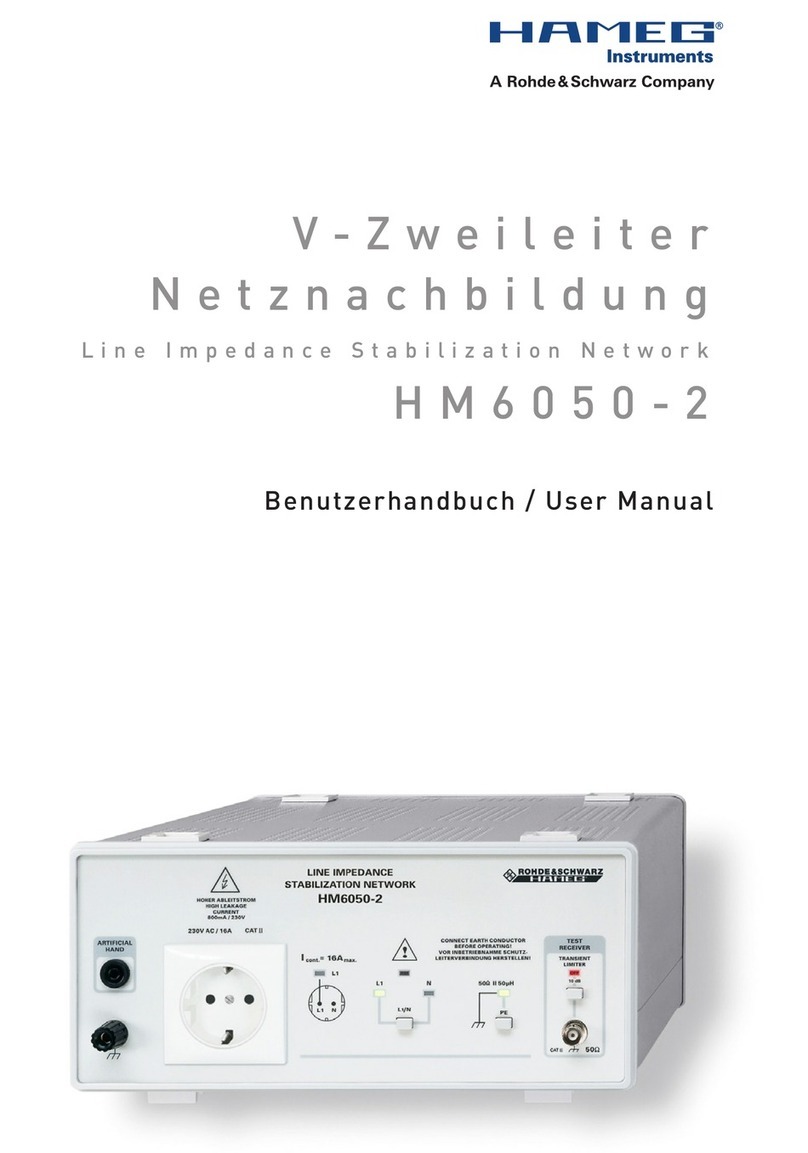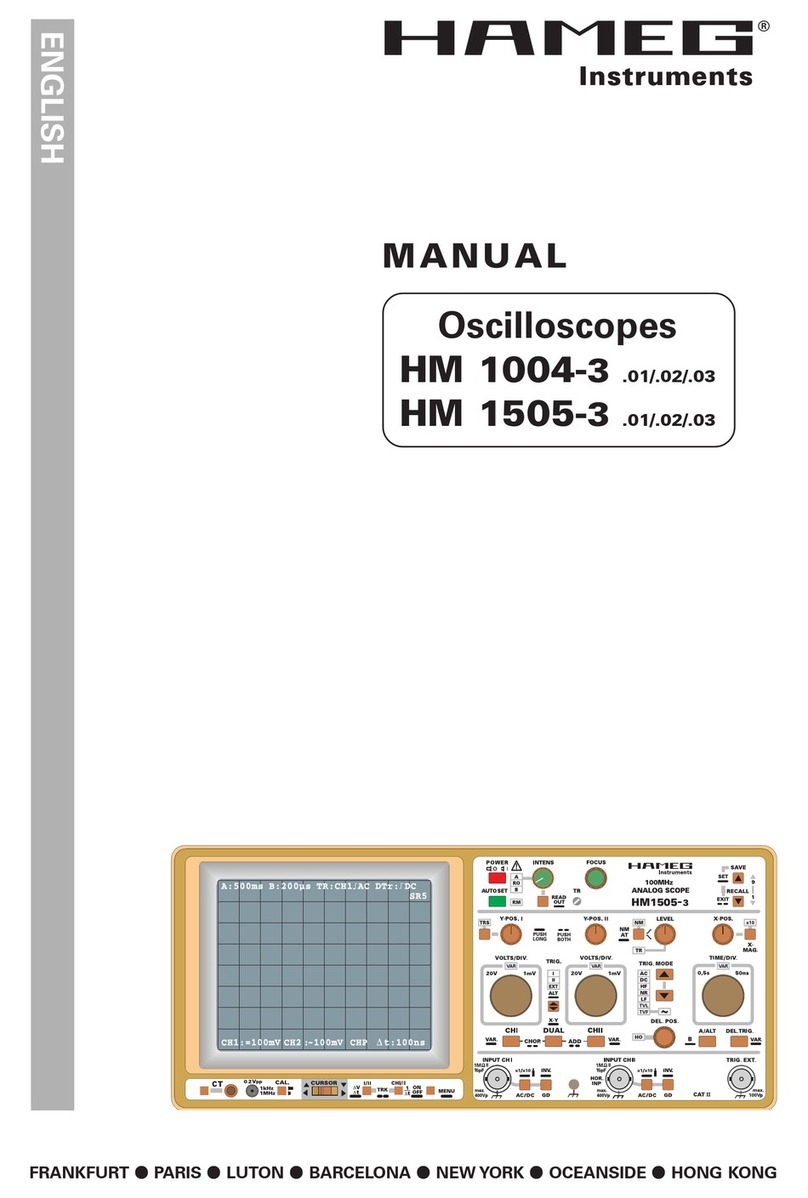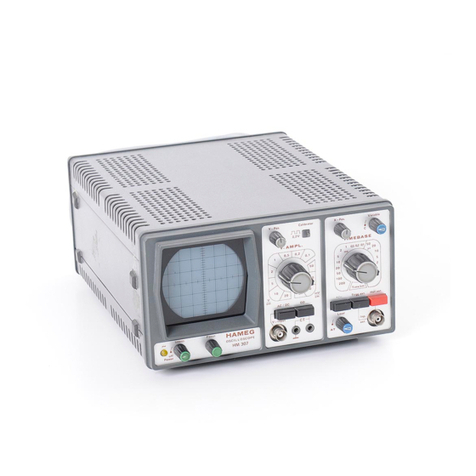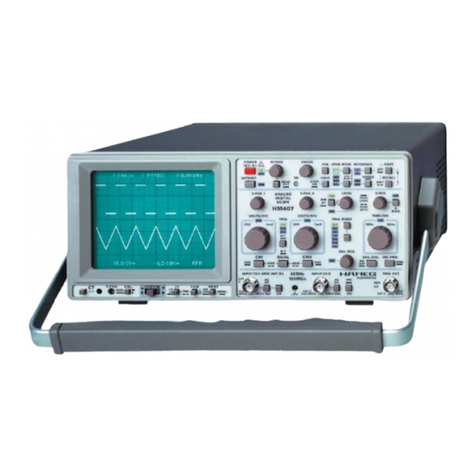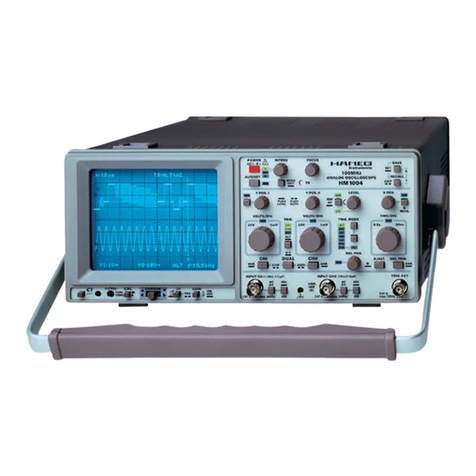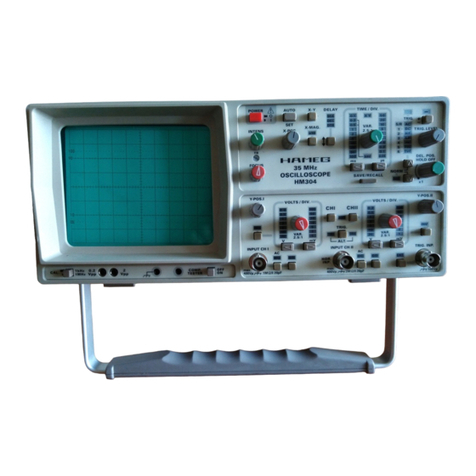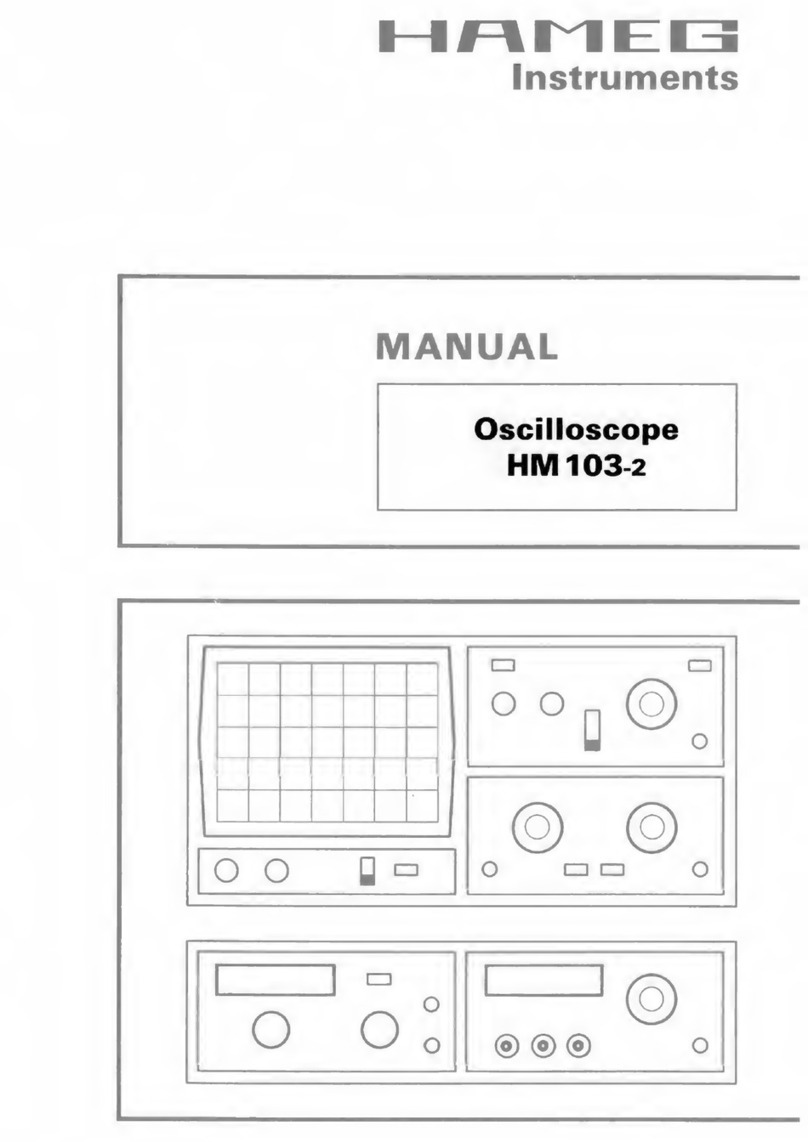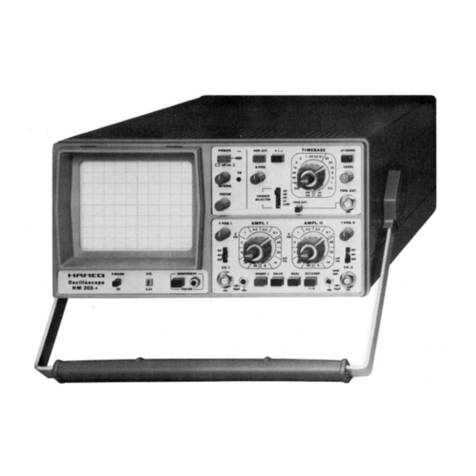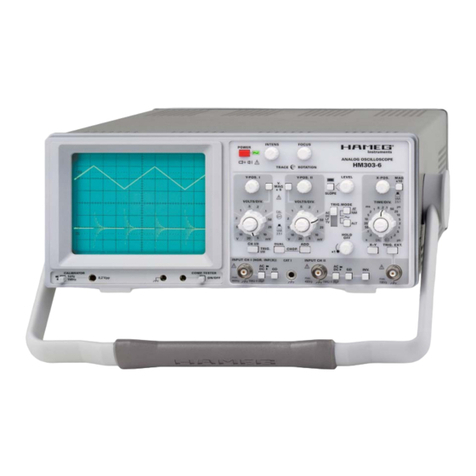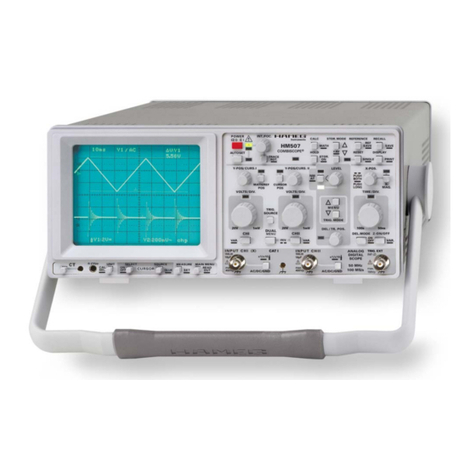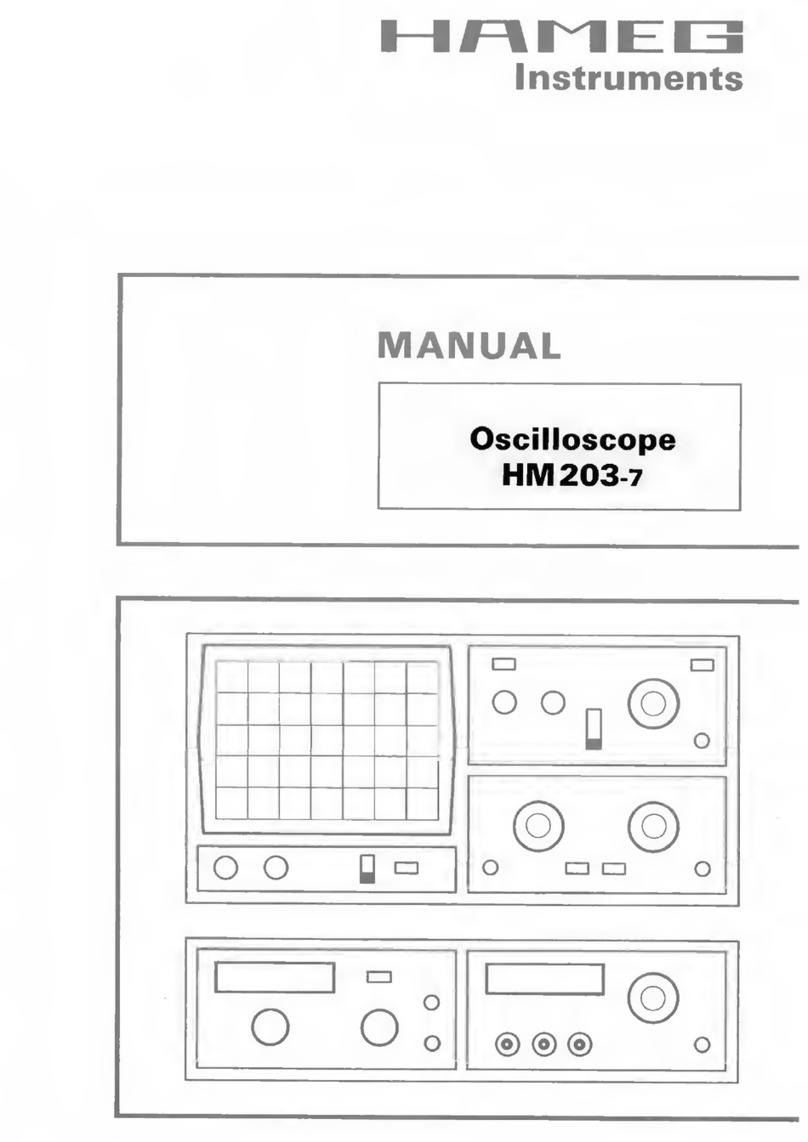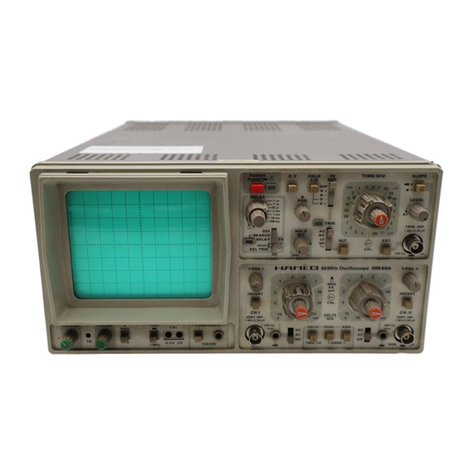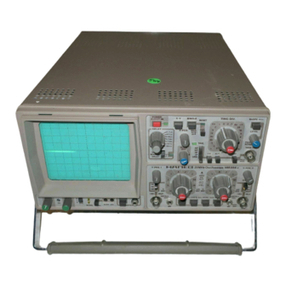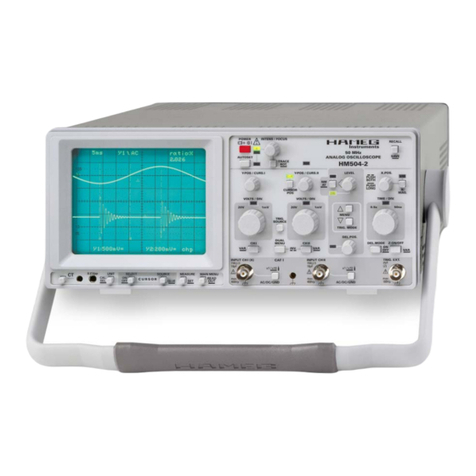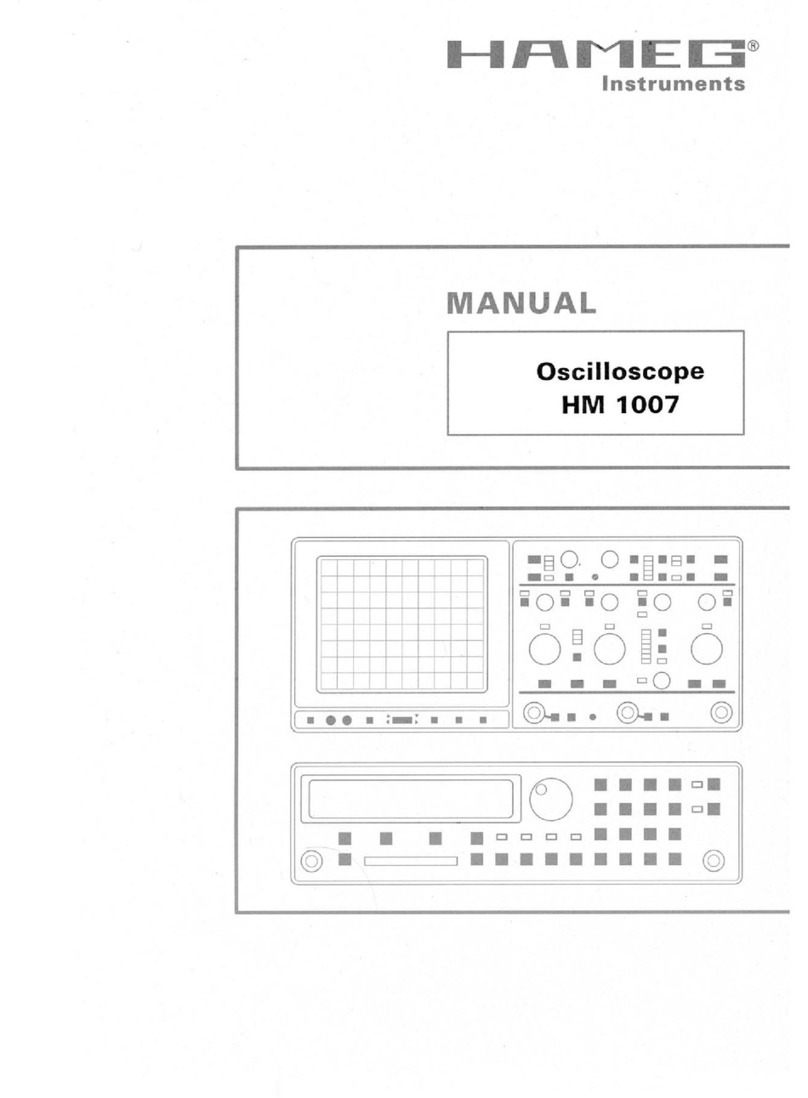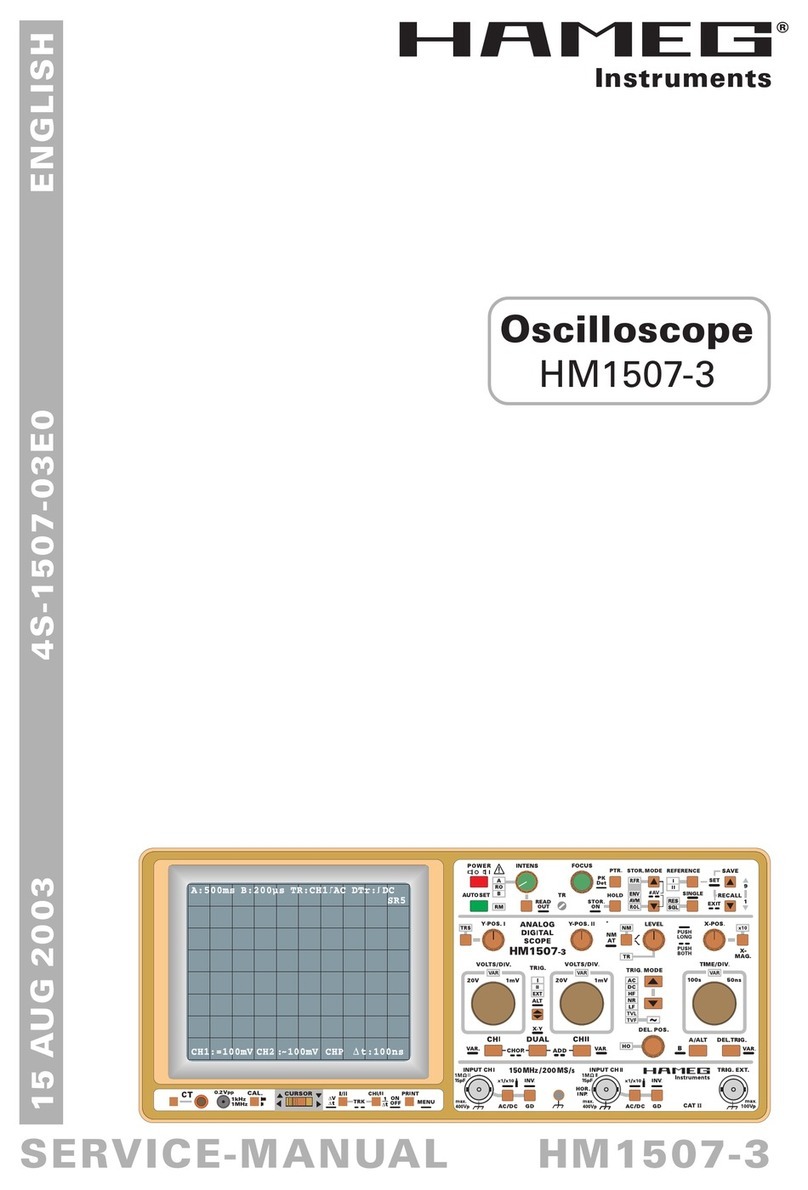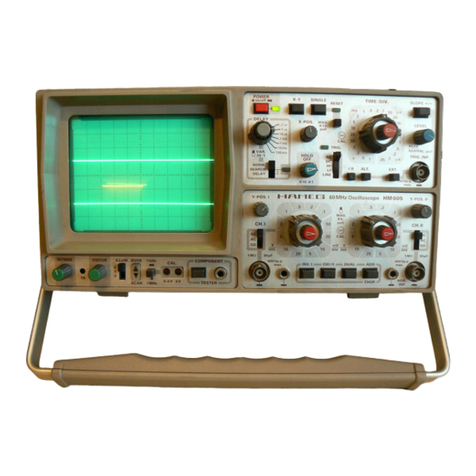
5
Subject to change without notice
HMO3524 / HMO3522 Technische Daten
350MHz 2 [4] Channel Digital Oscilloscope
HMO3522 [HMO3524]
All data valid at 23°C after 30 minute warm-up
Display
Display: 16.5cm (6.5”) VGA Color TFT
Resolution: 640 x 480 Pixel
Backlight: LED 400cd/m2
Display area for curves:
without menu 400 x 600 Pixel (8 x 12 div.)
with menu 400 x 500 Pixel (8 x 10div.)
Color depth: 256 colors
Intensity steps per channel: 0…31
Vertical System
Channels:
DSO mode CH 1, CH 2 [CH 1...CH 4]
MSO mode CH 1, CH 2, LCH 0...15 (logic channels)
with 2x Option HO3508
Auxiliary input: Frontside [Rear side]
Function Ext. Trigger
Impedance 1MΩ || 13pF ±2 pF
Coupling DC, AC
Max. input voltage 100V (DC + peak AC)
XYZ-mode: All analog channels on individual choise
Invert: CH 1, CH 2 [CH 1...CH 4]
Y-bandwidth (-3dB): 350MHz (5mV...5V)/div.
100MHz (1mV, 2mV)/div.
Lower AC bandwidth: 2Hz
Bandwidth limiter
(switchable):
approx. 20MHz
Rise time (calculated):<1ns
DC gain accuracy 2%
Input sensitivity: 12 calibrated steps
CH 1, CH 2 [CH 1...CH 4] 1mV/div.…5V/div. (1–2–5 Sequence)
Variable Between calibrated steps
Inputs CH 1, CH 2 [CH 1…CH 4]:
Impedance 1MΩ II 13pF ±2 pF (50 Ω switchable)
Coupling DC, AC, GND
Max. input voltage 200V (DC + peak AC), 50Ω <5Vrms
Measuring circuits: Measuring Category I (CAT I)
Position range ±10Divs
Offset control:
1mV, 2mV ±0.2V
5…50mV ±1V
100mV…5V ±20V
Logic channels With Option HO3508
Select. switching thresholds TTL, CMOS, ECL, 2x User -2…+8 V
Impedance 100kΩ || <4pF
Coupling DC
Max. input voltage 40V (DC + peak AC)
Triggering
Analog channels:
Automatic: Linking of peakdetection and triggerlevel
Min. signal height 0.8div; 0.5div typ.
Frequency range 5Hz…400MHz
Level control range From peak- to peak+
Normal (without peak):
Min. signal height 0.8div; 0.5div typ.
Frequency range 0…400MHz
Level control range -10...+10div.
Operating modes: Slope/Video/Logic/Pulse/Busses (optional)
Slope: Rising, falling, both
Sources: CH 1, CH 2, Line, Ext., LCH 0…15
[CH 1...CH 4, Line, Ext., LCH 0…15]
Coupling: AC: 5Hz...400MHz
DC: 0...400MHz
HF: 30kHz...400MHz
LF: 0...5kHz
Noise rejection: 100 MHz LPF switchable
Video:
Standards PAL, NTSC, SECAM, PAL-M, SDTV 576i,
HDTV 720p, HDTV 1080i, HDTV 1080p
Fields Field 1, field 2, both
Line All, selectable line number
Sync. Impulse Positive, negative
Source CH 1, CH 2, Ext. [CH 1...CH 4]
Logic: AND, OR, TRUE, FALSE
Source LCH 0…15
State LCH 0…15 X, H, L
Indicator for trigger action: LED
Ext. Trigger via: Auxiliary input 0,3V…10Vss
2nd Trigger:
Slope Rising, falling, both
Min. signal height 0.8div.; 0.5div. typ.
Frequency range 0…400MHz
Level control range -10...+10div.
Operating modes:
after time 20ns…0.1s
after incidence 1…216
Busses (Opt. HOO10): I2C/SPI/UART/RS-232
Source LCH 0...LCH 15
Format hexadecimal, binary
I2CTrigger on Start, Stop, Restart, ACK, NACK,
Adress (7 or 10Bit), Data, Adress and Data,
up to 10Mb/s
SPI up to 32Bit Data, Chip select (CS) pos.
or neg., without CS, up to 25Mb/s
UART/RS-232 up to 8Bit Data, up to 62.5Mb/s
Horizontal System
Domain representation: Time, Frequency (FFT), Voltage (XY)
Representation Time Base: Main-window, main- and zoom-window
Memory Zoom: Up to 100,000:1
Accuracy: 15ppm
Time Base:
Refresh operating modes 1 ns/div.…20ms/div.
Roll operating modes 50ms/div.…50s/div.
Digital Storage
Sampling rate (real time): 2x 2GSa/s, 1x 4GSa/s
[4x 2GSa/s, 2x 4GSa/s]
Logic channels: 16x 1GSa/s
Sampling rate (random):50GSa/s (n/a to logic channels)
Memory: 2x 2MPts, 1x 4MPts [4x 2MPts, 2x 4MPts]
Operation modes: Refresh, Average, Envelope, Peak-Detect
Roll: free run/triggered, Smooth
Resolution (vertical) 8Bit
Resolution (horizontal)
Yt Mode 50Pts./div.
XY Mode 8Bit
Interpolation: Sinx/x (CH 1...CH 4), Pulse (LCH 0...15)
Persistence: Off, 50ms...∞
Delay pretrigger: 0...2 Million x (1/samplerate)
posttrigger: 0...8 Million x (1/samplerate)
Display refresh rate: Up to 2500 waveforms/s
Display: Dots, vectors (interpolation), „persistence“
Reference memories: typ. 10 Traces
Operation/Measuring/Interfaces
Operation: Menu-driven (multilingual), Autoset,
help functions (multilingual)
Save/Recall memories: typ. 10 complete instrument parameter
settings
Frequency counter:
0.5Hz...350MHz 6 Digit resolution
Accuracy 15ppm
Auto measurements: Frequency, Period, pulse count,
Vpp, Vp+, Vp-, Vrms, Vavg, Vtop, Vbase, twidth+, twidth-,
tdutycycle+, tdutycycle, trise, tfall
pos. edge count, neg. edge count,
pos. pulse count, neg. pulse count
Cursor measurements: ∆V, ∆t, 1/∆t (f), V to Gnd, Vt related to
Trigger point, ratio X and Y, pulse count,
peak to peak, peak+, peak-
Interface: Dual-Interface USB/RS-232 (HO720)
USB-Stick (frontside)
USB-Printer (rear side) for Postscript Printer
DVI-D for ext. monitor
Optional: IEEE-488 (HO740), Ethernet/USB (HO730)
Display functions
Marker: up to 8 user definable marker for easy
navigation
VirtualScreen: virtual Display with 20div. vertical for all
Math-, Logic-, Bus- and Reference Signals
Busdisplay: up to 2 busses, user definable, parallel or
serial busses (option), decode of the bus
value in ASCII, binary, decimal or
hexadecimal, up to 4 lines
Parallel logic channels can also be used as source
for bus definition
I2C
(Opt. HOO10)
color coded Read- , Write Adress, Data,
Start, Stop, missing acknowledge, Errors
and Trigger condition
350MHz 2 [4] Channel Digital Oscilloscope
HMO3522 [HMO3524]
All data valid at 23°C after 30 minute warm-up
Display
Display: 16.5cm (6.5”) VGA Color TFT
Resolution: 640 x 480 Pixel
Backlight: LED 400cd/m2
Display area for curves:
without menu 400 x 600 Pixel (8 x 12 div.)
with menu 400 x 500 Pixel (8 x 10div.)
Color depth: 256 colors
Intensity steps per channel: 0…31
Vertical System
Channels:
DSO mode CH 1, CH 2 [CH 1...CH 4]
MSO mode CH 1, CH 2, LCH 0...15 (logic channels)
with 2x Option HO3508
Auxiliary input: Frontside [Rear side]
Function Ext. Trigger
Impedance 1MΩ || 13pF ±2 pF
Coupling DC, AC
Max. input voltage 100V (DC + peak AC)
XYZ-mode: All analog channels on individual choise
Invert: CH 1, CH 2 [CH 1...CH 4]
Y-bandwidth (-3dB): 350MHz (5mV...5V)/div.
100MHz (1mV, 2mV)/div.
Lower AC bandwidth: 2Hz
Bandwidth limiter
(switchable):
approx. 20MHz
Rise time (calculated):<1ns
DC gain accuracy 2%
Input sensitivity: 12 calibrated steps
CH 1, CH 2 [CH 1...CH 4] 1mV/div.…5V/div. (1–2–5 Sequence)
Variable Between calibrated steps
Inputs CH 1, CH 2 [CH 1…CH 4]:
Impedance 1MΩ II 13pF ±2 pF (50 Ω switchable)
Coupling DC, AC, GND
Max. input voltage 200V (DC + peak AC), 50Ω <5Vrms
Measuring circuits: Measuring Category I (CAT I)
Position range ±10Divs
Offset control:
1mV, 2mV ±0.2V
5…50mV ±1V
100mV…5V ±20V
Logic channels With Option HO3508
Select. switching thresholds TTL, CMOS, ECL, 2x User -2…+8 V
Impedance 100kΩ || <4pF
Coupling DC
Max. input voltage 40V (DC + peak AC)
Triggering
Analog channels:
Automatic: Linking of peakdetection and triggerlevel
Min. signal height 0.8div; 0.5div typ.
Frequency range 5Hz…400MHz
Level control range From peak- to peak+
Normal (without peak):
Min. signal height 0.8div; 0.5div typ.
Frequency range 0…400MHz
Level control range -10...+10div.
Operating modes: Slope/Video/Logic/Pulse/Busses (optional)
Slope: Rising, falling, both
Sources: CH 1, CH 2, Line, Ext., LCH 0…15
[CH 1...CH 4, Line, Ext., LCH 0…15]
Coupling: AC: 5Hz...400MHz
DC: 0...400MHz
HF: 30kHz...400MHz
LF: 0...5kHz
Noise rejection: 100 MHz LPF switchable
Video:
Standards PAL, NTSC, SECAM, PAL-M, SDTV 576i,
HDTV 720p, HDTV 1080i, HDTV 1080p
Fields Field 1, field 2, both
Line All, selectable line number
Sync. Impulse Positive, negative
Source CH 1, CH 2, Ext. [CH 1...CH 4]
Logic: AND, OR, TRUE, FALSE
Source LCH 0…15
State LCH 0…15 X, H, L
Indicator for trigger action: LED
Ext. Trigger via: Auxiliary input 0,3V…10Vss
2nd Trigger:
Slope Rising, falling, both
Min. signal height 0.8div.; 0.5div. typ.
Frequency range 0…400MHz
Level control range -10...+10div.
Operating modes:
after time 20ns…0.1s
after incidence 1…216
Busses (Opt. HOO10): I2C/SPI/UART/RS-232
Source LCH 0...LCH 15
Format hexadecimal, binary
I2CTrigger on Start, Stop, Restart, ACK, NACK,
Adress (7 or 10Bit), Data, Adress and Data,
up to 10Mb/s
SPI up to 32Bit Data, Chip select (CS) pos.
or neg., without CS, up to 25Mb/s
UART/RS-232 up to 8Bit Data, up to 62.5Mb/s
Horizontal System
Domain representation: Time, Frequency (FFT), Voltage (XY)
Representation Time Base: Main-window, main- and zoom-window
Memory Zoom: Up to 100,000:1
Accuracy: 15ppm
Time Base:
Refresh operating modes 1 ns/div.…20ms/div.
Roll operating modes 50ms/div.…50s/div.
Digital Storage
Sampling rate (real time): 2x 2GSa/s, 1x 4GSa/s
[4x 2GSa/s, 2x 4GSa/s]
Logic channels: 16x 1GSa/s
Sampling rate (random):50GSa/s (n/a to logic channels)
Memory: 2x 2MPts, 1x 4MPts [4x 2MPts, 2x 4MPts]
Operation modes: Refresh, Average, Envelope, Peak-Detect
Roll: free run/triggered, Smooth
Resolution (vertical) 8Bit
Resolution (horizontal)
Yt Mode 50Pts./div.
XY Mode 8Bit
Interpolation: Sinx/x (CH 1...CH 4), Pulse (LCH 0...15)
Persistence: Off, 50ms...∞
Delay pretrigger: 0...2 Million x (1/samplerate)
posttrigger: 0...8 Million x (1/samplerate)
Display refresh rate: Up to 2500 waveforms/s
Display: Dots, vectors (interpolation), „persistence“
Reference memories: typ. 10 Traces
Operation/Measuring/Interfaces
Operation: Menu-driven (multilingual), Autoset,
help functions (multilingual)
Save/Recall memories: typ. 10 complete instrument parameter
settings
Frequency counter:
0.5Hz...350MHz 6 Digit resolution
Accuracy 15ppm
Auto measurements: Frequency, Period, pulse count,
Vpp, Vp+, Vp-, Vrms, Vavg, Vtop, Vbase, twidth+, twidth-,
tdutycycle+, tdutycycle, trise, tfall
pos. edge count, neg. edge count,
pos. pulse count, neg. pulse count
Cursor measurements: ∆V, ∆t, 1/∆t (f), V to Gnd, Vt related to
Trigger point, ratio X and Y, pulse count,
peak to peak, peak+, peak-
Interface: Dual-Interface USB/RS-232 (HO720)
USB-Stick (frontside)
USB-Printer (rear side) for Postscript Printer
DVI-D for ext. monitor
Optional: IEEE-488 (HO740), Ethernet/USB (HO730)
Display functions
Marker: up to 8 user definable marker for easy
navigation
VirtualScreen: virtual Display with 20div. vertical for all
Math-, Logic-, Bus- and Reference Signals
Busdisplay: up to 2 busses, user definable, parallel or
serial busses (option), decode of the bus
value in ASCII, binary, decimal or
hexadecimal, up to 4 lines
Parallel logic channels can also be used as source
for bus definition
I2C
(Opt. HOO10)
color coded Read- , Write Adress, Data,
Start, Stop, missing acknowledge, Errors
and Trigger condition
350MHz 2 [4] Channel Digital Oscilloscope
HMO3522 [HMO3524]
All data valid at 23°C after 30 minute warm-up
Display
Display: 16.5cm (6.5”) VGA Color TFT
Resolution: 640 x 480 Pixel
Backlight: LED 400cd/m2
Display area for curves:
without menu 400 x 600 Pixel (8 x 12 div.)
with menu 400 x 500 Pixel (8 x 10div.)
Color depth: 256 colors
Intensity steps per channel: 0…31
Vertical System
Channels:
DSO mode CH 1, CH 2 [CH 1...CH 4]
MSO mode CH 1, CH 2, LCH 0...15 (logic channels)
with 2x Option HO3508
Auxiliary input: Frontside [Rear side]
Function Ext. Trigger
Impedance 1MΩ || 13pF ±2 pF
Coupling DC, AC
Max. input voltage 100V (DC + peak AC)
XYZ-mode: All analog channels on individual choise
Invert: CH 1, CH 2 [CH 1...CH 4]
Y-bandwidth (-3dB): 350MHz (5mV...5V)/div.
100MHz (1mV, 2mV)/div.
Lower AC bandwidth: 2Hz
Bandwidth limiter
(switchable):
approx. 20MHz
Rise time (calculated):<1ns
DC gain accuracy 2%
Input sensitivity: 12 calibrated steps
CH 1, CH 2 [CH 1...CH 4] 1mV/div.…5V/div. (1–2–5 Sequence)
Variable Between calibrated steps
Inputs CH 1, CH 2 [CH 1…CH 4]:
Impedance 1MΩ II 13pF ±2 pF (50 Ω switchable)
Coupling DC, AC, GND
Max. input voltage 200V (DC + peak AC), 50Ω <5Vrms
Measuring circuits: Measuring Category I (CAT I)
Position range ±10Divs
Offset control:
1mV, 2mV ±0.2V
5…50mV ±1V
100mV…5V ±20V
Logic channels With Option HO3508
Select. switching thresholds TTL, CMOS, ECL, 2x User -2…+8 V
Impedance 100kΩ || <4pF
Coupling DC
Max. input voltage 40V (DC + peak AC)
Triggering
Analog channels:
Automatic: Linking of peakdetection and triggerlevel
Min. signal height 0.8div; 0.5div typ.
Frequency range 5Hz…400MHz
Level control range From peak- to peak+
Normal (without peak):
Min. signal height 0.8div; 0.5div typ.
Frequency range 0…400MHz
Level control range -10...+10div.
Operating modes: Slope/Video/Logic/Pulse/Busses (optional)
Slope: Rising, falling, both
Sources: CH 1, CH 2, Line, Ext., LCH 0…15
[CH 1...CH 4, Line, Ext., LCH 0…15]
Coupling: AC: 5Hz...400MHz
DC: 0...400MHz
HF: 30kHz...400MHz
LF: 0...5kHz
Noise rejection: 100 MHz LPF switchable
Video:
Standards PAL, NTSC, SECAM, PAL-M, SDTV 576i,
HDTV 720p, HDTV 1080i, HDTV 1080p
Fields Field 1, field 2, both
Line All, selectable line number
Sync. Impulse Positive, negative
Source CH 1, CH 2, Ext. [CH 1...CH 4]
Logic: AND, OR, TRUE, FALSE
Source LCH 0…15
State LCH 0…15 X, H, L
Indicator for trigger action: LED
Ext. Trigger via: Auxiliary input 0,3V…10V
ss
2nd Trigger:
Slope Rising, falling, both
Min. signal height 0.8div.; 0.5div. typ.
Frequency range 0…400MHz
Level control range -10...+10div.
Operating modes:
after time 20ns…0.1s
after incidence 1…216
Busses (Opt. HOO10): I2C/SPI/UART/RS-232
Source LCH 0...LCH 15
Format hexadecimal, binary
I2CTrigger on Start, Stop, Restart, ACK, NACK,
Adress (7 or 10Bit), Data, Adress and Data,
up to 10Mb/s
SPI up to 32Bit Data, Chip select (CS) pos.
or neg., without CS, up to 25Mb/s
UART/RS-232 up to 8Bit Data, up to 62.5Mb/s
Horizontal System
Domain representation: Time, Frequency (FFT), Voltage (XY)
Representation Time Base: Main-window, main- and zoom-window
Memory Zoom: Up to 100,000:1
Accuracy: 15ppm
Time Base:
Refresh operating modes 1 ns/div.…20ms/div.
Roll operating modes 50ms/div.…50s/div.
Digital Storage
Sampling rate (real time): 2x 2GSa/s, 1x 4GSa/s
[4x 2GSa/s, 2x 4GSa/s]
Logic channels: 16x 1GSa/s
Sampling rate (random):50GSa/s (n/a to logic channels)
Memory: 2x 2MPts, 1x 4MPts [4x 2MPts, 2x 4MPts]
Operation modes: Refresh, Average, Envelope, Peak-Detect
Roll: free run/triggered, Smooth
Resolution (vertical) 8Bit
Resolution (horizontal)
Yt Mode 50Pts./div.
XY Mode 8Bit
Interpolation: Sinx/x (CH 1...CH 4), Pulse (LCH 0...15)
Persistence: Off, 50ms...∞
Delay pretrigger: 0...2 Million x (1/samplerate)
posttrigger: 0...8 Million x (1/samplerate)
Display refresh rate: Up to 2500 waveforms/s
Display: Dots, vectors (interpolation), „persistence“
Reference memories: typ. 10 Traces
Operation/Measuring/Interfaces
Operation: Menu-driven (multilingual), Autoset,
help functions (multilingual)
Save/Recall memories: typ. 10 complete instrument parameter
settings
Frequency counter:
0.5Hz...350MHz 6 Digit resolution
Accuracy 15ppm
Auto measurements: Frequency, Period, pulse count,
Vpp, Vp+, Vp-, Vrms, Vavg, Vtop, Vbase, twidth+, twidth-,
tdutycycle+, tdutycycle, trise, tfall
pos. edge count, neg. edge count,
pos. pulse count, neg. pulse count
Cursor measurements: ∆V, ∆t, 1/∆t (f), V to Gnd, Vt related to
Trigger point, ratio X and Y, pulse count,
peak to peak, peak+, peak-
Interface: Dual-Interface USB/RS-232 (HO720)
USB-Stick (frontside)
USB-Printer (rear side) for Postscript Printer
DVI-D for ext. monitor
Optional: IEEE-488 (HO740), Ethernet/USB (HO730)
Display functions
Marker: up to 8 user definable marker for easy
navigation
VirtualScreen: virtual Display with 20div. vertical for all
Math-, Logic-, Bus- and Reference Signals
Busdisplay: up to 2 busses, user definable, parallel or
serial busses (option), decode of the bus
value in ASCII, binary, decimal or
hexadecimal, up to 4 lines
Parallel logic channels can also be used as source
for bus definition
I2C
(Opt. HOO10)
color coded Read- , Write Adress, Data,
Start, Stop, missing acknowledge, Errors
and Trigger condition
